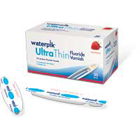
The paints also get into the saliva after application by abrasion so small amounts can be swallowed. To prevent overdose, the dentist or dental staff only apply small amounts to the teeth. In addition to these preparations, there are many other dental products or cosmetics that can release fluoride. However, their effectiveness has not yet been sufficiently demonstrated in scientific studies. The studies clearly show the importance of the process of fluoride varnish in the long run.
Risks of fluoridation
Fluoride is a non-hazardous salt of fluorine that does not occur naturally. In food, fluoride is found mainly in marine animals, in soy food and in black tea. Fluoride is vital for building teeth and bones. The dosage used for dental treatment is harmless to the human body. Only exceeding the fluoride limit values can lead to complications: If more than 1.5 milligrams of fluoride per day are administered, melt damage can occur. Especially in the phase of development around the sixth year of age, it can lead to tooth fluorosis on the permanent teeth. This change is reflected in white discoloration in the enamel and can lead to uneven enamel formation.
In addition to the damage to the teeth, fluoride incorporation into the bone can lead to skeletal fluorosis. This is an increase in bone density, which in the advanced stage can lead to a compression of the bone tissue with reduced extensibility and increased brittleness osteosclerosis, to the new bone formation on the bone surface exostoses, to muscle wasting or to nervous neurological disorders. As a result, the muscle function, but also the kidney function can be impaired.

In order to avoid damage by fluorides, therefore, various fluoride preparations should not be combined with each other uncontrollably. The preparation of a treatment plan by the dentist, possibly in consultation with the pediatrician makes sense. This must take into account both the fluoride concentrations of the local drinking water and the daily intake through the diet. The treatment with fluoride concentrates paints; gels are not in the hands of the patient; only the dentist or a dental professional may perform them.
Alternatives to fluoridation
In addition to fluoridation, a low-sugar diet and targeted oral cleansing through regular teeth cleaning are among the most important protective measures to prevent tooth decay.
The protection by the fluorides is achieved primarily by the hardening of the enamel. The inhibition of bacterial growth by fluorides, however, is low, so that the removal of bacteria by brushing and by the dental cleaning is the best prevention against tooth decay.
In addition, regular semi-annual examinations, annual examination, and treatment as part of the bonus program of the statutory health insurance funds should be carried out at the dentist individual prophylaxis program for children and adolescents under the bonus program. They shed light on the need for additional professional fluoridation.
Disclaimer
This text is for information purposes only and is intended to convey first contents to patients and their relatives in order to better understand individual examination and therapy steps. This information does not replace a doctor’s visit and is not a self-treatment request and should not be used to make self-diagnosis or self-medication.

